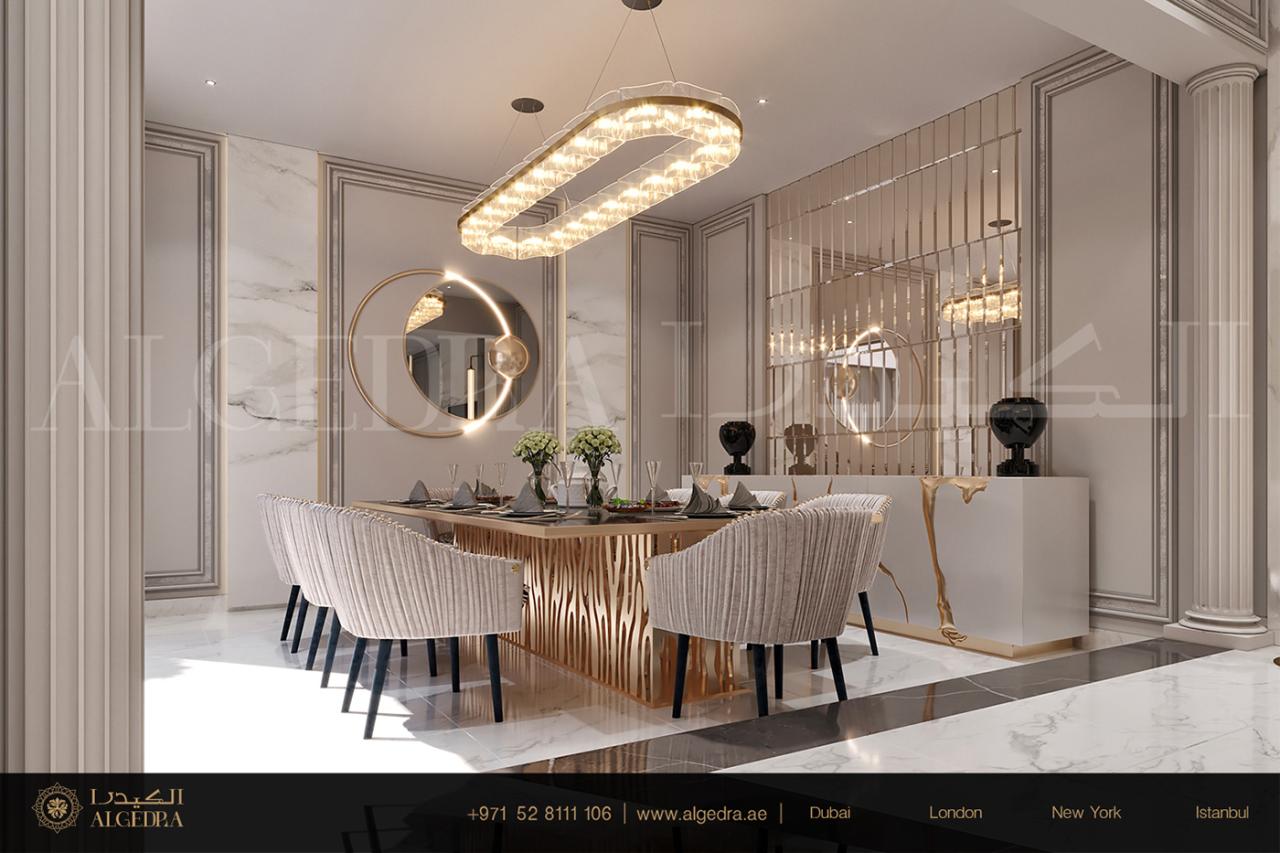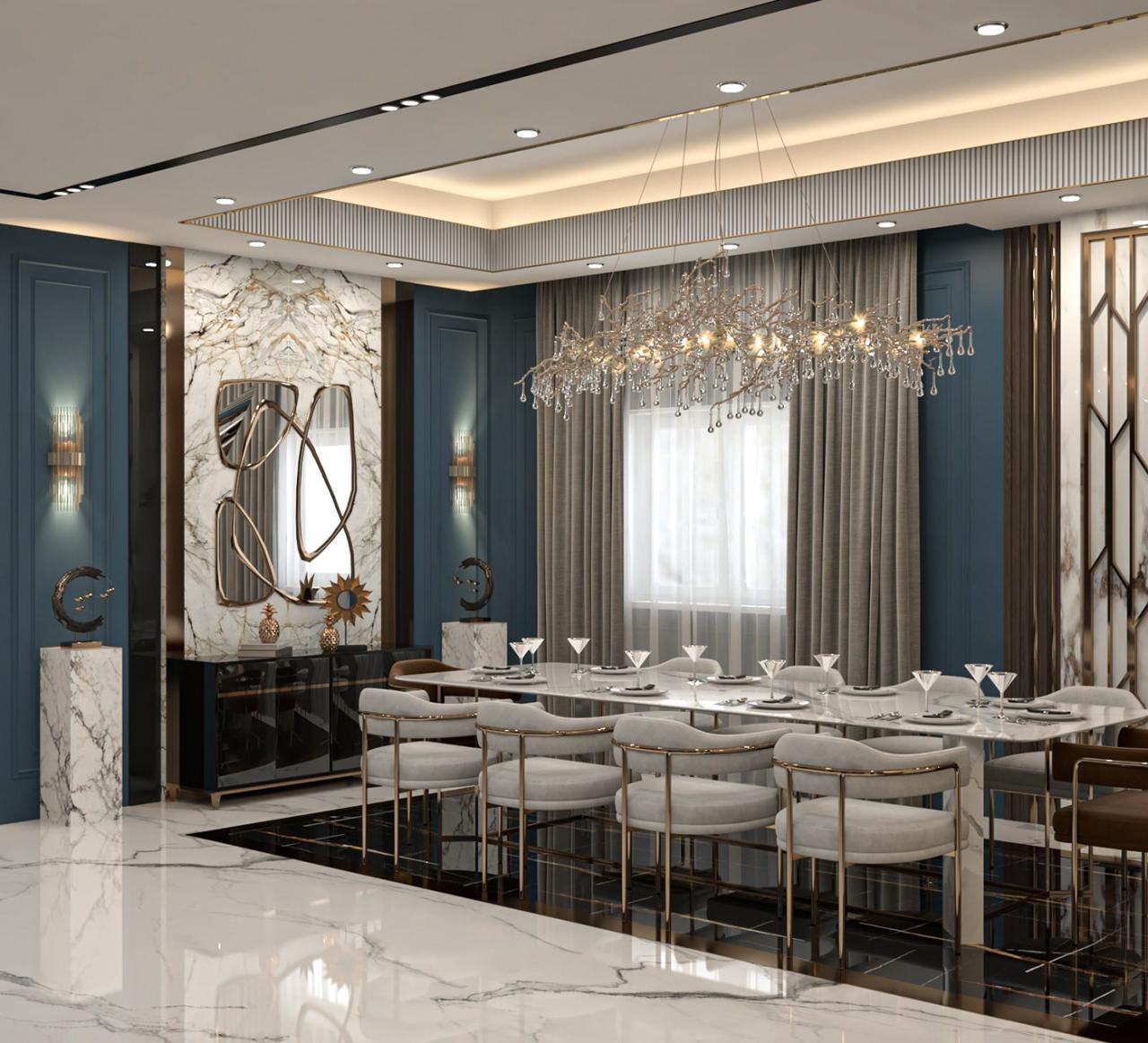Luxury dining room design is about more than just aesthetics; it’s about crafting an experience. From the exquisite materials to the carefully considered lighting, every detail contributes to a memorable and luxurious dining setting. This guide delves into the key elements of designing a truly exceptional dining room, encompassing everything from choosing the perfect furniture to creating the right ambiance.
This exploration will cover the fundamentals of luxury dining room design, including defining luxury, selecting materials, and creating the perfect atmosphere. We’ll also examine current trends and how to incorporate them into your own unique design vision.
Defining Luxury Dining Room Design

Source: behance.net
A luxury dining room isn’t just a place to eat; it’s an experience. It’s a statement of taste, a reflection of opulence, and a space designed to impress. Beyond the aesthetics, a luxury dining room prioritizes functionality and comfort, creating an atmosphere that elevates the dining experience to a new level. This involves thoughtful consideration of every detail, from the choice of materials to the arrangement of the furniture.
The key differentiator between a luxury dining room and a standard one lies in the meticulous attention to detail and the use of high-quality materials and craftsmanship. Luxury dining rooms aim to create an atmosphere of sophistication and comfort that elevates the dining experience.
Key Characteristics of Luxury Dining Rooms
Luxury dining rooms are distinguished by several key characteristics. These go beyond mere aesthetics and encompass the overall ambiance and functionality of the space. They embody an aura of timeless elegance and refined sophistication.
- Exceptional Craftsmanship: The craftsmanship in a luxury dining room is evident in every element, from the intricate carvings on the furniture to the precise joinery of the cabinetry. This attention to detail ensures that each piece is not only beautiful but also durable and long-lasting. Master artisans are often involved in the creation of bespoke furniture, showcasing a high level of skill and expertise.
- High-Quality Materials: Luxury dining rooms use premium materials, such as solid wood, high-end marble, and luxurious fabrics. These materials are not just aesthetically pleasing; they also contribute to the room’s durability and longevity. For instance, a meticulously crafted mahogany table, combined with fine leather upholstery, creates a timeless and substantial feel.
- Sophisticated Ambiance: The ambiance in a luxury dining room is deliberately crafted to evoke a sense of grandeur and sophistication. Soft lighting, luxurious textiles, and carefully selected artwork combine to create a relaxing and refined atmosphere.
- Thoughtful Functionality: Luxury dining rooms are designed not only to be beautiful but also to be functional. The layout and furniture arrangements should support the desired activities, such as hosting large dinner parties or enjoying intimate meals with loved ones. Space planning is key.
Comparison of Styles
Different styles of luxury dining rooms reflect varying tastes and preferences. Classic, contemporary, and modern styles each offer distinct approaches to design.
- Classic: Classic luxury dining rooms typically feature ornate details, rich colors, and traditional furniture designs. They often incorporate elements like intricate carvings, gilded accents, and plush fabrics, evoking a sense of history and grandeur. Think mahogany tables with intricate carvings and velvet upholstery.
- Contemporary: Contemporary luxury dining rooms prioritize clean lines, minimalist aesthetics, and sophisticated materials. They often feature sleek furniture, neutral color palettes, and an emphasis on modern design principles. Sleek, chrome-accented tables, with glass or stone tops, paired with modern, upholstered chairs exemplify this style.
- Modern: Modern luxury dining rooms embrace a bold and often abstract aesthetic. They use geometric shapes, bold colors, and unconventional materials to create a dynamic and artistic atmosphere. The use of metallic accents, raw materials, and exposed structures are key elements.
Luxury Dining Table Layout
The table layout is a crucial aspect of the dining room experience, influencing the flow and interaction of guests. A well-designed layout enhances the overall ambiance.
| Element | Description |
|---|---|
| Seating Arrangement | The placement of chairs around the table is essential. Consider the flow of conversation and the ability of guests to interact comfortably. A balanced arrangement with a mix of facing and semi-facing chairs encourages interaction. |
| Table Settings | Table settings should reflect the overall aesthetic. Fine china, crystal glassware, and silverware, combined with appropriate placemats and napkins, create a luxurious and refined impression. Matching patterns and textures add a layer of cohesion. |
| Centerpieces | Centerpieces are an important design element. Consider using fresh flowers, elegant sculptures, or candles to enhance the aesthetic appeal. The choice of centerpiece should complement the overall style of the dining room. |
Materials and Finishes
Creating a luxurious dining room involves careful selection of materials and finishes that evoke a sense of opulence and sophistication. The interplay of textures, colors, and materials creates an atmosphere that’s both inviting and memorable. The right choices can transform a space from ordinary to extraordinary.
High-end dining rooms often feature a curated combination of natural materials, sophisticated finishes, and thoughtful integration of lighting to achieve a truly luxurious feel. This combination not only enhances the aesthetic appeal but also contributes to the overall comfort and ambiance of the space.
Marble
Marble is a classic choice for luxury dining rooms due to its timeless beauty and elegant veining. Its natural variations create a unique and striking focal point. Different types of marble, like Calacatta, Carrara, or Statuario, offer distinct appearances, allowing for customization to suit the specific design aesthetic. For instance, a Calacatta slab can create a stunning backdrop for a dining table, while Statuario marble might be used for a refined countertop.
Wood
High-quality wood, such as walnut, mahogany, or ebony, adds warmth and sophistication to a dining room. Wood can be used for tables, chairs, or even paneling. The rich tones and textures of wood create a cozy and inviting ambiance. The choice of wood type and finish will influence the overall feel of the room, ranging from a rustic, natural look to a more refined, polished style. For instance, a mahogany dining table with a polished finish can elevate the room’s aesthetic.
Leather, Luxury dining room design
Leather, with its luxurious feel and durability, is frequently used for chairs, bar stools, or even wall accents in luxury dining rooms. Different types of leather, such as top-grain leather or full-grain leather, have varying degrees of softness and durability. Leather upholstery, particularly in rich colors like deep brown or burgundy, can enhance the luxurious character of the space. Leather seating can contribute to a sophisticated and inviting atmosphere.
Finishes and Textures
A luxurious dining room benefits from carefully considered finishes and textures. Paint colors, wallpaper, and lighting can elevate the room’s visual appeal. Soft, muted tones like cream, beige, or gray can create a serene atmosphere, while bolder colors like emerald green or deep blues can add a touch of drama. For example, a dining room with deep emerald green walls and gold accents can exude an air of opulence.
Natural Elements
Integrating natural elements into a luxury dining room design can bring a sense of tranquility and connection to nature. Natural light, plants, and wood accents can create a warm and inviting atmosphere. Large windows that allow natural light to flood the room can create a sense of spaciousness and connection to the outdoors. Fresh flowers or potted plants strategically placed can further enhance the natural aesthetic. Examples include using reclaimed wood, incorporating stone features, or incorporating natural fiber rugs.
Sustainable Materials
Sustainable materials are increasingly important in luxury design. Bamboo, reclaimed wood, and recycled glass are examples of materials that can minimize the environmental impact of the design. Using these materials can contribute to a more conscious and responsible approach to interior design while maintaining a high-quality aesthetic. For instance, using bamboo flooring in place of hardwood can be a sustainable and luxurious choice.
High-End Materials and Finishes
| Material | Finish | Suitability for Luxury Dining Rooms |
|---|---|---|
| Solid walnut wood | Polished or lacquered | Excellent for tables and chairs, adds warmth and richness. |
| Calacatta marble | Honed or polished | Stunning countertops and backsplashes, showcasing natural veining. |
| Top-grain leather | Hand-stitched or machine-stitched | Luxurious seating, adding durability and sophistication. |
| Recycled glass | Etched or painted | Unique and modern aesthetic for lighting fixtures or tabletops. |
| Bamboo | Stained or oiled | Eco-friendly flooring or wall panels, offers a natural look. |
Lighting and Ambiance
Lighting is a crucial element in crafting a luxurious dining experience. It sets the mood, highlights key design features, and ultimately impacts the overall ambiance of the room. A well-considered lighting strategy elevates the dining area from a functional space to a truly captivating environment. Proper lighting enhances the aesthetic appeal and creates a warm, inviting atmosphere that encourages guests to linger and enjoy the meal.
Careful consideration of lighting choices and their strategic placement is essential to achieve the desired effect. It’s not just about brightness; it’s about creating layers of light to sculpt the space and evoke a specific feeling. This involves understanding the various types of lighting available and how to effectively combine them to create the perfect atmosphere.
Impact of Lighting on Ambiance
Lighting profoundly influences the overall ambiance of a luxury dining room. Warm, diffused light creates a welcoming and intimate atmosphere, while brighter, more focused light can evoke a sense of sophistication and elegance. The right lighting can transform a simple meal into a memorable event.
Lighting Options for a Luxurious Dining Experience
A luxurious dining experience benefits from a combination of lighting types. Chandeliers, often a focal point, add a touch of grandeur and visual interest. Recessed lighting provides ambient illumination, subtly illuminating the room and creating a sense of spaciousness. Ambient lighting, such as strategically placed wall sconces or floor lamps, further enhances the overall atmosphere. These elements, used in harmony, contribute to the dining room’s luxurious feel.
Highlighting Architectural Features and Artwork
Specific lighting techniques can draw attention to architectural details and artwork within the dining room. Directional spotlights or track lighting can effectively highlight intricate moldings, sculptures, or paintings. By strategically focusing light on these elements, their beauty is amplified, transforming them into captivating focal points. Careful consideration of the artwork’s color and style is key when choosing the appropriate lighting.
Creating Moods and Atmospheres
Different moods and atmospheres can be achieved within a luxury dining room through the manipulation of lighting. Soft, warm light is ideal for creating an intimate and romantic setting, perfect for a candlelit dinner. Brighter, cooler light might be better suited for a more formal or contemporary dining experience. Adjusting the intensity and color temperature of the lighting can subtly shift the ambiance from relaxed to celebratory.
Balancing Different Types of Lighting
A balanced approach to lighting is essential for achieving a warm and inviting ambiance. A single, overly bright chandelier might overwhelm the room, while a dimly lit space could feel claustrophobic. Combining ambient lighting with accent lighting and task lighting creates a harmonious blend, enabling a dynamic interplay of light and shadow. By carefully considering the interplay of light sources, a comfortable and luxurious atmosphere is achieved.
Furniture and Seating
Creating a luxurious dining experience hinges significantly on the choice of furniture. High-quality materials, meticulous craftsmanship, and thoughtful design elements elevate the dining room from merely functional to truly exceptional. Beyond aesthetics, the pieces must also prioritize comfort and ergonomics, ensuring guests feel welcomed and appreciated throughout their meal.
Key Characteristics of Luxury Dining Room Furniture
Luxury dining room furniture is characterized by several key attributes. It often showcases intricate details, from carved embellishments to polished surfaces. Solid wood construction, often of rare or high-quality hardwoods, is a hallmark. Finishes are meticulously applied, enhancing the natural beauty of the wood or adding a touch of elegance through lacquering or staining. The overall impression is one of refined sophistication and timeless appeal.
Scale and Proportion in Luxury Dining Room Furniture
The scale and proportion of dining room furniture are critical to the overall ambiance. A table that’s too large or too small for the space can disrupt the flow and feel of the room. Conversely, carefully considered proportions can create a harmonious balance, inviting guests to engage in the space comfortably. For example, a large, expansive dining table in a grand dining room might be paired with oversized, ornate chairs, while a smaller table in a more intimate space might be accompanied by smaller, more slender chairs. This mindful attention to scale and proportion ensures the furniture seamlessly integrates with the room’s design.
Fabric and Upholstery Choices
The selection of fabrics and upholstery is crucial in luxury dining room furniture. High-quality fabrics like velvet, linen, or leather, often in rich colors and textures, are common choices. Velvet, with its luxurious drape and tactile qualities, adds a touch of opulence. Linen, known for its natural beauty and breathability, offers a more casual yet elegant feel. Leather, particularly in high-quality leathers like top-grain cowhide or exotic skins, conveys sophistication and durability. The chosen fabric not only enhances the visual appeal but also contributes to the overall comfort and longevity of the seating.
Comfort and Ergonomics in Luxury Dining Room Seating
Luxury dining room seating must prioritize both comfort and ergonomics. Chairs should offer a supportive back and a comfortable seat, encouraging guests to linger and enjoy the meal. The shape and padding should be tailored to the specific needs of the user. Features like adjustable backs or armrests can further enhance comfort and accommodate different body types. A focus on ergonomic design ensures that guests can sit comfortably for extended periods without experiencing discomfort or strain. Examples of such ergonomic designs include chairs with adjustable lumbar support or curved backs that follow the natural contours of the spine.
Dining Table Styles and Suitability
| Dining Table Style | Suitability |
|---|---|
| Traditional | Formal dining rooms, emphasizing classic elegance and grandeur. |
| Modern | Contemporary or minimalist designs, showcasing clean lines and sleek aesthetics. |
| Rustic | Country-style dining rooms, emphasizing natural materials and warmth. |
| Round | Intimate settings, encouraging conversation and interaction among guests. |
| Oval | More versatile, suitable for both formal and informal settings, offering a good balance between spaciousness and intimacy. |
| Rectangular | Larger dining areas, accommodating a greater number of guests while maintaining a sense of formality. |
The choice of table style directly impacts the overall design and function of the dining room. Matching the table style to the desired ambiance and guest capacity is key to creating a truly luxurious and inviting dining space.
Art and Decor
The right artwork and decor can elevate a dining room from simply functional to truly luxurious. Careful selection of pieces can create a cohesive and visually stunning space that reflects the homeowner’s taste and style. Well-chosen accents, from sculptures to textiles, can add depth and personality to the room, setting the stage for memorable dining experiences.
Thoughtful integration of art and decor complements the materials, finishes, lighting, and furniture, creating a harmonious and luxurious atmosphere. The key is to find a balance that doesn’t overwhelm the space but rather enhances the overall design.
Artwork Selection
Selecting artwork that complements the dining room’s design is crucial for a cohesive aesthetic. Consider the room’s color palette and overall style when choosing pieces. If the room features warm tones and rich textures, artwork with similar qualities can create a visually appealing unity. Conversely, contrasting artwork can add a touch of visual interest, but this should be done thoughtfully. For example, a bold, modern painting in a traditional dining room can add a surprising element of sophistication. The size of the artwork should also be proportionate to the size of the room and the furniture. A large painting in a small room might overwhelm the space, while a small piece in a vast room might appear lost.
Sculptures, Paintings, and Tapestries
Sculptures, paintings, and tapestries can all play a vital role in enhancing the luxury feel of a dining room. Sculptures add a touch of elegance and drama, particularly if they are crafted from high-quality materials like marble or bronze. Paintings can bring color, texture, and personality to the space, mirroring the dining room’s style. Large-scale paintings can create a focal point, while smaller, framed pieces can add subtle details. Tapestries, with their intricate patterns and rich colors, can provide a luxurious and textural element, especially in rooms with a more traditional or historical feel. Consider the subject matter of the art and how it aligns with the overall theme.
Decorative Elements
Decorative elements like vases, candles, and textiles add a layer of sophistication and personality. Vases, whether simple or ornate, can be filled with fresh flowers or greenery to introduce a touch of nature and vibrancy. Candles, in various sizes and styles, can create a warm and inviting ambiance, enhancing the dining room’s atmosphere. Textiles, such as table runners or placemats, can add a touch of luxury and texture, coordinating with the overall design. For example, a linen runner with a silk tablecloth and embroidered placemats create a luxurious and sophisticated look.
Accent Items for Luxury Dining Rooms
A thoughtfully curated selection of decorative accents can greatly enhance the luxury aesthetic of a dining room.
- High-quality tableware: Crystal or porcelain dishes, silverware, and glassware add a touch of sophistication and elevate the dining experience.
- Statement lighting fixtures: Chandeliers or elaborate pendant lights can create a dramatic focal point and enhance the room’s ambiance.
- Exceptional textiles: Silk or velvet drapes, cushions, and tablecloths add richness and luxury to the space.
- Intricate wall panels: Ornate wall panels can add a touch of grandeur and visual interest.
- Rare or collectible items: Antique or vintage pieces can add a touch of history and character.
- Hand-blown glass objects: These unique pieces add a touch of artistry and elegance.
Space Planning and Functionality
A well-planned dining room isn’t just about aesthetics; it’s about functionality. Careful space planning ensures the room serves its purpose seamlessly, whether it’s hosting intimate dinners or large family gatherings. This section details crucial aspects of maximizing space, optimizing traffic flow, and integrating essential features like butler’s pantries and wine cellars into the design.
A luxury dining room, more than just a place to eat, should be a space that reflects the lifestyle and personality of its occupants. Thoughtful planning ensures the room can comfortably accommodate various activities and preferences, from formal dinners to casual family meals. Understanding the optimal dimensions and layout, and considering the integration of other spaces, are key to creating a truly functional and luxurious dining experience.
Importance of Space Planning
Proper space planning in a luxury dining room is critical for creating a comfortable and efficient environment. It’s about more than just fitting furniture; it’s about optimizing the flow of movement, ensuring adequate space for guests, and integrating the room seamlessly with other parts of the home. A well-planned space minimizes bottlenecks and maximizes the room’s overall usability.
Maximizing Space and Traffic Flow
Maximizing space in a luxury dining room can be achieved through strategic furniture placement. Avoid overcrowding the room with unnecessary items. Consider using furniture with integrated storage or multifunctional designs. A thoughtful layout will improve the flow of traffic, ensuring guests can move around easily and comfortably. This includes strategically placing doorways and entrances to avoid congestion.
Incorporating Butler’s Pantries and Wine Cellars
Butler’s pantries and wine cellars are luxurious additions to a dining room, providing both functionality and visual appeal. A butler’s pantry can serve as a dedicated workspace for preparing and serving food, freeing up space in the kitchen. A wine cellar, whether integrated or separate, showcases a sophisticated appreciation for fine wines. Design considerations should focus on aesthetics and functionality, ensuring seamless integration with the overall dining room design.
Optimal Dining Room Dimensions
The optimal dimensions of a dining room depend on the anticipated use and number of guests. A smaller dining room, around 120 square feet, is suitable for intimate gatherings. A medium-sized dining room, approximately 150-200 square feet, can comfortably accommodate a larger number of guests and more complex arrangements. Larger dining rooms, above 200 square feet, allow for more flexibility and elaborate layouts. The height of the ceiling and the proportions of the room also influence the overall ambiance and functionality.
Layout with Family Room or Kitchen
Designing a dining room that seamlessly connects with a family room or kitchen requires careful attention to traffic flow. Consider using open layouts or connecting spaces through archways or large windows. Ensure there’s enough space between furniture pieces to allow for comfortable movement. The dining area should feel like an extension of the other rooms, not an isolated space. This requires carefully considering the flow of movement between rooms.
Color Palettes and Themes: Luxury Dining Room Design

Source: behance.net
Choosing the right color palette is crucial in creating a luxury dining room. It sets the tone for the entire space, influencing the mood and ambiance, and ultimately enhancing the overall experience. Careful consideration of colors, their interplay, and how they respond to the architectural style and materials, will contribute to a truly unforgettable dining experience.
Color Palettes for Luxury Dining Rooms
Color palettes play a significant role in defining the atmosphere of a dining room. Warm and inviting tones create intimacy, while cool and sophisticated palettes project elegance and grandeur. The key is to select hues that complement the architectural style, materials, and desired mood.
- Warm Tones: These palettes often include rich browns, deep reds, golds, and warm beiges. These colors create a sense of coziness and comfort, perfect for intimate gatherings. Think of a rustic-chic dining room with exposed beams, warm wood tones, and deep burgundy accents. This creates a welcoming atmosphere that feels inviting and sophisticated.
- Cool Tones: Gray, navy, and deep teal palettes are excellent choices for creating a sophisticated and elegant ambiance. These colors evoke a sense of calm and refinement, ideal for formal dinners or more quiet gatherings. A dining room with slate gray walls, complemented by dark wood furniture and metallic accents, will exude an air of refined elegance.
- Neutral Tones: A palette of creams, whites, and soft grays creates a versatile backdrop. This approach allows the furniture, artwork, and other decorative elements to take center stage. These palettes are timeless and work well with various architectural styles, making them a popular choice for modern and contemporary dining rooms.
- Accent Colors: Bold accent colors like emerald green, sapphire blue, or deep crimson can be used strategically to add a pop of vibrancy and drama to a neutral palette. These colors can be used in smaller accents like throw pillows, artwork, or even a statement rug to create a dynamic and engaging space without overwhelming the room. For example, a dining room with cream walls and light oak furniture can be given a touch of luxury with emerald green accents in the form of a tablecloth or dining chairs.
Color Selection and Architectural Style
Selecting colors that harmonize with the architectural style is essential. For example, a classic French-inspired dining room might benefit from warm, rich colors like deep burgundy or gold, while a modern contemporary design could embrace cool grays, whites, and metallic accents. The interplay between the architectural details and the chosen color palette is crucial for a seamless and visually appealing design. The chosen colors should enhance the inherent characteristics of the room.
Creating Warmth and Intimacy
Warm colors like rich reds, golds, and warm browns, in addition to soft lighting, can create a sense of warmth and intimacy. These colors encourage conversation and create a welcoming atmosphere. The use of textured fabrics, like velvet or wool, can further enhance the feeling of warmth and luxury. For example, using warm lighting, such as candles or warm-toned pendant lights, will enhance the feeling of intimacy and comfort.
Impact of Color Palettes on Mood
Different color palettes evoke various moods and ambiance. Warm colors generally create a sense of comfort and relaxation, while cool colors tend to promote a feeling of calmness and sophistication. Consider the overall mood you want to achieve when selecting colors for your dining room. A color palette should support the overall purpose of the dining room.
Color Palette Examples and Moods
| Color Palette | Mood | Theme |
|---|---|---|
| Cream, gold, and taupe | Sophisticated, elegant | Modern, classic |
| Deep burgundy, gold, and cream | Warm, inviting | Rustic, French-inspired |
| Gray, navy, and silver | Calm, sophisticated | Modern, contemporary |
| Emerald green, cream, and gold | Vibrant, luxurious | Eclectic, nature-inspired |
Luxury Dining Room Trends
Dining rooms, once solely functional spaces, are now evolving into sophisticated and personalized havens within a home. Luxury dining room design reflects this shift, incorporating not just aesthetic appeal but also a deep understanding of space planning, comfort, and the overall lifestyle of the occupants. This evolution is driven by a blend of emerging trends, historical influences, and the desire for unique experiences.
Current Trends in Luxury Dining Room Design
Luxury dining rooms are embracing a fusion of styles, moving away from rigid adherence to traditional aesthetics. Open-concept designs are becoming increasingly popular, blurring the lines between the dining area and other living spaces. This creates a sense of fluidity and allows for a more seamless flow of social interaction. Natural materials, like wood and stone, are also prominent, providing warmth and an intimate atmosphere. Furthermore, a growing appreciation for sustainable and ethically sourced materials is shaping choices, adding a layer of responsibility to design decisions.
Evolution of Luxury Dining Room Design Over Time
Historically, luxury dining rooms were grand statements of wealth and status. Formal settings with ornate furniture and intricate details dominated the scene. Over time, however, the emphasis shifted. Contemporary designs now prioritize comfort and functionality, while still maintaining a sense of elegance. The rise of global influences has also led to a more eclectic approach, incorporating elements from various cultures and eras. The evolution reflects a move towards personalized spaces that align with the homeowner’s lifestyle and preferences.
Future of Luxury Dining Room Trends
The future of luxury dining rooms will likely be characterized by personalization and sustainability. Personalized experiences will become more prominent, with design elements tailored to specific needs and preferences. A growing emphasis on creating adaptable spaces that can transform to accommodate various functions, like home offices or informal gatherings, will also be a key trend. The use of technology to enhance the dining experience, such as smart lighting and automated features, will continue to gain traction.
Contemporary vs. Traditional Approaches
Contemporary luxury dining rooms often favor clean lines, minimalist aesthetics, and the use of modern materials. They prioritize functionality and efficiency, creating spaces that are both stylish and practical. Traditional designs, in contrast, emphasize ornate details, rich textures, and classic furniture styles, often evoking a sense of history and grandeur. The key difference lies in the balance between aesthetics, functionality, and the overall message the space conveys.
Factors Influencing Current Luxury Dining Room Trends
Several factors are driving the current trends in luxury dining room design. The increasing desire for personalized experiences is a significant motivator, as homeowners seek to create spaces that reflect their individual styles and lifestyles. Technological advancements also play a role, as homeowners are incorporating smart home technology to enhance the functionality and ambiance of their dining areas. A growing awareness of sustainability is impacting material choices, pushing designers to embrace eco-friendly and ethically sourced options. Finally, the integration of open-concept living is changing how dining rooms are used and perceived within the home, leading to a more fluid and interconnected design philosophy.
Final Thoughts
In conclusion, crafting a luxury dining room is a journey of meticulous planning and thoughtful execution. By carefully considering materials, lighting, furniture, and décor, you can create a space that is not only beautiful but also functional and deeply inviting. This guide provides a comprehensive overview, equipping you with the knowledge to design a dining room that reflects your personal style and elevates your dining experience.
FAQ Compilation
What are some sustainable materials suitable for luxury dining rooms?
Bamboo, reclaimed wood, and responsibly sourced marble are excellent choices for creating a luxurious and eco-friendly dining room. Look for certifications like FSC for wood to ensure responsible sourcing.
How can I create a sense of warmth and intimacy in a large dining room?
Use warm-toned lighting, soft fabrics, and strategically placed seating groupings to break up the space and create cozy corners. Adding personal touches, like family photos or artwork, can also make the room feel more inviting.
What are some common lighting mistakes to avoid in a luxury dining room?
Overly bright or harsh lighting can ruin the ambiance. Ensure a balance of ambient, task, and accent lighting to create a warm and inviting atmosphere, avoiding overly harsh spotlights or glaring chandeliers.
What are some budget-friendly ways to incorporate luxury elements in my dining room design?
Focus on high-quality materials in key areas, like the table or seating, and incorporate unique decorative pieces. Don’t be afraid to mix high-end pieces with more affordable accessories to create a balanced and sophisticated look.
- Obscure Glass A Detailed Look - June 2, 2025
- Home Automation System Your Smart Home Guide - May 6, 2025
- Urban Modern Home Design & Lifestyle - May 6, 2025







